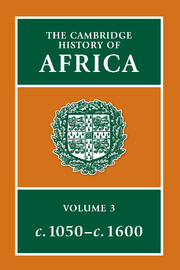Book contents
- Frontmatter
- Introduction: some interregional themes
- 1 Egypt, Nubia and the Eastern Deserts
- 2 Ethiopia, the Red Sea and the Horn
- 3 The East Coast, Madagascar and the Indian Ocean
- 4 The eastern Maghrib and the central Sudan
- 5 The western Maghrib and Sudan
- 6 Upper and Lower Guinea
- 7 Central Africa from Cameroun to the Zambezi
- 8 Southern Africa
- 9 The East African interior
- Bibliographical Essays
- Bibliography
- Index
Bibliographical Essays
Published online by Cambridge University Press: 28 March 2008
- Frontmatter
- Introduction: some interregional themes
- 1 Egypt, Nubia and the Eastern Deserts
- 2 Ethiopia, the Red Sea and the Horn
- 3 The East Coast, Madagascar and the Indian Ocean
- 4 The eastern Maghrib and the central Sudan
- 5 The western Maghrib and Sudan
- 6 Upper and Lower Guinea
- 7 Central Africa from Cameroun to the Zambezi
- 8 Southern Africa
- 9 The East African interior
- Bibliographical Essays
- Bibliography
- Index
Summary
EGYPT, NUBIA AND THE EASTERN DESERTS
Among works of reference, an indispensable instrument for all aspects of Islam and the Arabic world remains the five-volume The Encyclopaedia of Islam, 1st edn (1913-38). The standard introduction and bibliography is Cahen, Jean Sauvaget's introduction to the history of the Muslim East (1965), which gives a systematic regional and thematic arrangement of the available source material. For continuous acquaintance with the periodical literature, the student should follow either Pearson, Index Islamicus (1958, and supplements 1962, 1967, 1972), or Abstracta lslamica, a supplement to the Revue des Etudes Islamiqms (since 1927), which contains short evaluations and registers work done in Arabic.
Unlike other parts of the Arab world (or for that matter of the Middle East and of the rest of Africa), Egypt is in the privileged position of possessing a quantity of primary archival material for its history before the fifteenth century. For the period before the tenth and eleventh centuries there are a number of papyri dealing with administrative, juristic and even private matters. The richest collection is that of the Egyptian Library, cf. Grohmann (1934-62 and 1954). A limited quantity of other primary material (deeds, state correspondence, decrees etc.) is preserved from the Fatimid period, e.g. the letters of the caliph al- Mustansir, ed. Magid (1954), and the Fatimid Decrees in Stern (1964). The Ayyubid and Mamluk epochs seem to be rich in this material, but so far only some parts have been made accessible or catalogued; useful introductions to these materials are Atiya (1955), for Ayyubid official documents, and Ernst (i960), for those of the Mamluk sultans.
- Type
- Chapter
- Information
- The Cambridge History of Africa , pp. 670 - 701Publisher: Cambridge University PressPrint publication year: 1977



